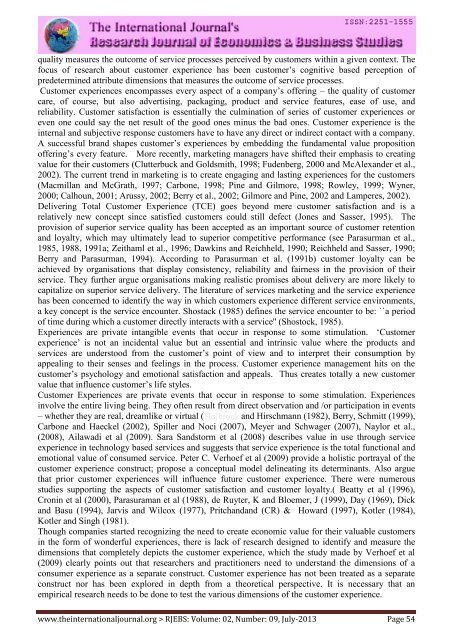Research Journal of Economics & Business Studies - RJEBS - The ...
Research Journal of Economics & Business Studies - RJEBS - The ...
Research Journal of Economics & Business Studies - RJEBS - The ...
Create successful ePaper yourself
Turn your PDF publications into a flip-book with our unique Google optimized e-Paper software.
quality measures the outcome <strong>of</strong> service processes perceived by customers within a given context. <strong>The</strong><br />
focus <strong>of</strong> research about customer experience has been customer’s cognitive based perception <strong>of</strong><br />
predetermined attribute dimensions that measures the outcome <strong>of</strong> service processes.<br />
Customer experiences encompasses every aspect <strong>of</strong> a company’s <strong>of</strong>fering – the quality <strong>of</strong> customer<br />
care, <strong>of</strong> course, but also advertising, packaging, product and service features, ease <strong>of</strong> use, and<br />
reliability. Customer satisfaction is essentially the culmination <strong>of</strong> series <strong>of</strong> customer experiences or<br />
even one could say the net result <strong>of</strong> the good ones minus the bad ones. Customer experience is the<br />
internal and subjective response customers have to have any direct or indirect contact with a company.<br />
A successful brand shapes customer’s experiences by embedding the fundamental value proposition<br />
<strong>of</strong>fering’s every feature. More recently, marketing managers have shifted their emphasis to creating<br />
value for their customers (Clutterbuck and Goldsmith, 1998; Fudenberg, 2000 and McAlexander et al.,<br />
2002). <strong>The</strong> current trend in marketing is to create engaging and lasting experiences for the customers<br />
(Macmillan and McGrath, 1997; Carbone, 1998; Pine and Gilmore, 1998; Rowley, 1999; Wyner,<br />
2000; Calhoun, 2001; Arussy, 2002; Berry et al., 2002; Gilmore and Pine, 2002 and Lamperes, 2002).<br />
Delivering Total Customer Experience (TCE) goes beyond mere customer satisfaction and is a<br />
relatively new concept since satisfied customers could still defect (Jones and Sasser, 1995). <strong>The</strong><br />
provision <strong>of</strong> superior service quality has been accepted as an important source <strong>of</strong> customer retention<br />
and loyalty, which may ultimately lead to superior competitive performance (see Parasurman et al.,<br />
1985, 1988, 1991a; Zeithaml et al., 1996; Dawkins and Reichheld, 1990; Reichheld and Sasser, 1990;<br />
Berry and Parasurman, 1994). According to Parasurman et al. (1991b) customer loyalty can be<br />
achieved by organisations that display consistency, reliability and fairness in the provision <strong>of</strong> their<br />
service. <strong>The</strong>y further argue organisations making realistic promises about delivery are more likely to<br />
capitalize on superior service delivery. <strong>The</strong> literature <strong>of</strong> services marketing and the service experience<br />
has been concerned to identify the way in which customers experience different service environments,<br />
a key concept is the service encounter. Shostack (1985) defines the service encounter to be: ``a period<br />
<strong>of</strong> time during which a customer directly interacts with a service'' (Shostock, 1985).<br />
Experiences are private intangible events that occur in response to some stimulation. ‘Customer<br />
experience’ is not an incidental value but an essential and intrinsic value where the products and<br />
services are understood from the customer’s point <strong>of</strong> view and to interpret their consumption by<br />
appealing to their senses and feelings in the process. Customer experience management hits on the<br />
customer’s psychology and emotional satisfaction and appeals. Thus creates totally a new customer<br />
value that influence customer’s life styles.<br />
Customer Experiences are private events that occur in response to some stimulation. Experiences<br />
involve the entire living being. <strong>The</strong>y <strong>of</strong>ten result from direct observation and /or participation in events<br />
– whether they are real, dreamlike or virtual (Holbrook and Hirschmann (1982), Berry, Schmitt (1999),<br />
Carbone and Haeckel (2002), Spiller and Noci (2007), Meyer and Schwager (2007), Naylor et al.,<br />
(2008), Ailawadi et al (2009). Sara Sandstorm et al (2008) describes value in use through service<br />
experience in technology based services and suggests that service experience is the total functional and<br />
emotional value <strong>of</strong> consumed service. Peter C. Verhoef et al (2009) provide a holistic portrayal <strong>of</strong> the<br />
customer experience construct; propose a conceptual model delineating its determinants. Also argue<br />
that prior customer experiences will influence future customer experience. <strong>The</strong>re were numerous<br />
studies supporting the aspects <strong>of</strong> customer satisfaction and customer loyalty.( Beatty et al (1996),<br />
Cronin et al (2000), Parasuraman et al (1988), de Ruyter, K and Bloemer, J (1999), Day (1969), Dick<br />
and Basu (1994), Jarvis and Wilcox (1977), Pritchandand (CR) & Howard (1997), Kotler (1984),<br />
Kotler and Singh (1981).<br />
Though companies started recognizing the need to create economic value for their valuable customers<br />
in the form <strong>of</strong> wonderful experiences, there is lack <strong>of</strong> research designed to identify and measure the<br />
dimensions that completely depicts the customer experience, which the study made by Verhoef et al<br />
(2009) clearly points out that researchers and practitioners need to understand the dimensions <strong>of</strong> a<br />
consumer experience as a separate construct. Customer experience has not been treated as a separate<br />
construct nor has been explored in depth from a theoretical perspective. It is necessary that an<br />
empirical research needs to be done to test the various dimensions <strong>of</strong> the customer experience.<br />
www.theinternationaljournal.org > <strong>RJEBS</strong>: Volume: 02, Number: 09, July-2013 Page 54
















